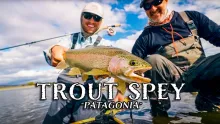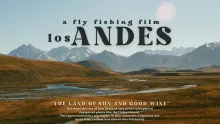The white perch is actually an anadromous silver bass in the fish family Moronidae. This game panfish is the little cousin of the striped bass and shares much of the same habitat: the brackish tidal estuaries and adjacent rivers of the mid-Atlantic and New England states.
When you catch a fish species on the fly for the first time the experience can be either the end part of a careful plan or the spontaneous starting point of a new passion. The latter describes my introduction to the white perch; a matter of happy chance. I also consider the moment of our meeting lucky. Neil Peart, the cycling travel author and rock drummer for the Canadian band Rush, has described luck in his prose as preparation meeting opportunity. This definition succinctly represents my first encounter with this fish. Since that balmy summer evening spent along a tidal river -- when my searching streamer pattern first found a receptive, rising white perch -- the species has catalyzed my approach to the sport. This pursuit has come to balance the freshwater and saltwater fishing techniques of the artificial fly within a dynamic natural environment where the one constant is the one called fun.
The white perch is actually an anadromous silver bass in the fish family Moronidae. This game panfish is the little cousin of the striped bass and shares much of the same habitat: the brackish tidal estuaries and adjacent rivers of the mid-Atlantic and New England states. White perch are found also in Lake Erie and are especially prevalent in the cool, clear ponds of Maine and Massachusetts. Wherever one is caught, an angler’s first white perch can cause confusion. Juveniles are the size of sunfish, possess a few faint horizontal stripes above the lateral line, and resemble immature striped bass. White perch are more streamlined, though, and have a distinctly concave head. This shape is retained in adults that range from eight to twelve inches in length and one to two pounds in weight. Veterans of this size know the water, as this species can reach a relatively old fish age of ten to twelve years. How and why this bass came to be known as a perch can be traced to a mistaken classification during the colonial era when the fish was first described as Perca americana.

A Fish With a Past
American shad were not the sole fish valued by the colonial founding fishers of the United States. White perch have the look and solid feel of silver dollars and were an equally important commercial fish. So popular was the white perch that when the oldest club of its kind in the world, The Schuylkill Fishing Company, formed near Philadelphia in 1732, the white perch was adopted onto its flag of state. The heraldry evolved into a single white perch in profile, surrounded by a circle of 13 stars and a red, white, and blue backdrop. The Revolutionary War had by then begun, and Generals George Washington and Marquis de Lafayette met and dined on white perch in the club’s well-appointed fish house. The society still exists today along the Schuylkill River's banks. There members enjoy an annual ritual, a tasteful blend of tradition and secrecy, that involves both the catch and culinary preparation of the species.

Fly-fishing for White Perch
Traditional fly rod techniques for stripers work well for white perch. The key difference to consider is hook size. A 2/0 Clouser Minnow will never do. The same pattern, scaled down to a panfish-friendly size 8 or 10, takes the little cousin’s preferred size of forage into proper consideration. Other classic streamer patterns like Lefty’s Deceiver, the Mickey Finn, and the Gray Ghost can at times work wonders on white perch.
Trout enthusiasts may be delighted to know another series of patterns, bead head caddis, have proven to be successful flies for these fish. The same casting techniques used for trout need only be modified in scope for the slower, warmer water that white perch prefer. Colors to match the hatch, in this case minnows and fish fry, seem to follow the rule “the lighter the better” for white perch. White, cream, and pale green patterns can all be fished effectively. The overall light tone and the flash of the bead in motion must imitate a literal “shiner” in the eyes of these aggressive, sprinting fish.
White perch bite best during spring peak tides and are somewhat nocturnal, preferring to strike most often during the two hours bordering both sunrise and sunset. One exception is areas lit by lights. Like schooling striped bass, white perch congregate below the swarms of minnows attracted to the lamps flanking roads and bridges. On the evening I discovered the effectiveness of caddis pupae imitations under artificial light, I landed over a dozen fish from one large pool in the Schuylkill River. The area was brightly lit by nearby sodium streetlights. The tide was low enough to read the river's current seams leading into the holding zone. The combination of night light, low tide, and flashing bead provided plentiful action -- and fun -- on that memorable Friday evening in Philadelphia.
The most effective presentation of a fly mimics panic. When feeding, schools of white perch will chase baitfish to the surface in the same way as the bluefish. Pods of the frantic little fish will break water and skip along the surface in all directions in the effort to escape. Target casts toward these eruptions, which occur in otherwise calm, or smoothly flowing, water. Start by stripping the streamer across the surface in the same manic manner. If that does not lead to a strike, a sinking tip fly line or a small amount of non-toxic split shot can drop the pattern down the water column. Wherever the first fish strikes, one can be sure another half dozen may follow.
This strategy works equally well in stillwater environments. Anglers who fish for white perch in ponds should concentrate their efforts after dark around docks, piers, and jetties, not so much for the structure as the light. These surface areas can become wrinkled and roiled from the nighttime drama of big fish, little fish.
The emerald shiner is one such baitfish found in many of the same waterways as white perch. A pattern I developed to imitate this specific swimming hatch takes its cue from the minnow's overall hue; I call it the Green Guarantee. The recipe is a simple, quick tie and combines the structure of a bearded nymph with the elongated shape of a classic bucktail. Wrap a streamlined body of green thread and floss around the shank of a standard streamer hook, with or without a deer hair tail, and finish at the head with pheasant tail fibers folded underneath, tied off, and trimmed to form the traditional beard. Fished upstream with a strip retrieve, this pattern, in motion, creates an impressionistic, swimming, emerald silhouette.

Feathered Fishers are an Angler’s Friend
A fly caster need not pursue surface disturbances, especially if a hunting school moves toward water that is unsafe to wade or boat. When feeding frenzies move out of double haul range, or into dangerous water, seek other indicators along the river. Fishing birds, particularly cormorants and herons, are as good as a human guide. Cormorants maneuver into position above schools of fish and dive down to dinner. Herons stalk the pools and eddies where manic minnows have been chased.
Many fishers malign the avian angler, particularly cormorants, probably because these birds are so adept at fishing circles around the nearby humans thrashing the water with a stick. I subscribe to the view that a cormorant is like the best kind of guide -- someone who shares the water with you, stays out of your way, and at the same time selflessly points you toward fish.
One of my most memorable white perch expeditions was inextricably linked with a cormorant. The evening high tide was rising fast during a pleasant June evening, and the term “wet wading” was taking on added meaning. The knee-deep water I had been working was nearing my waist, but the bite was on; I could not -- and would not -- quit because of a little damp discomfort above the waders. The best fish, and fishing trips, are most often earned. My extra sense perceived a special opportunity, and I was prepared to play out the moment, even if I had to end up all wet.
A cormorant came flying into view. The bird’s dark, aerodynamic body cut a shape as sharp as an American stealth jet fighter, and it made a soft landing not twenty feet from me. The bird immediately went under and emerged a moment later thirty feet farther down with either a herring or an alewife stuck in the middle of its grinning profile. My booted feet bounced sideways along the cobbled bottom as I followed downstream, flowing nicely along with the thick, lazy current. The sky was a deep blue, decorated by a few clouds tinted the same soft pink as the sun setting behind me. There was the slightest hint of brackishness in the air, and I felt as in synch with the tidal rhythm as if I had been in the ocean surf. I internalized an intimacy with that spot of nature, caught a mess of white perch, and I had my feathered guide to thank for it. I caught fish by following the bird that was following the baitfish that the white perch were feeding upon.
The constant presence of the cormorant and other fishing birds hints at another one of the white perch’s qualities. This fish is undoubtedly among the favored prey of these feathered predators. While I practice catch-and-release as a rule, I am also aware the white perch is an excellent food fish for both bird and man. Spawning fish in tidal rivers have been fattened up in fertile estuaries full of squid, shrimp, and fish fry. Savory preparations go as far back as colonial times. A signature dish of the Schuylkill Fishing Company -- white perch fried in “the best butter of the market” -- stands as a recipe that has remained on course with American history.

The White Perch Kit
Basic Rig
5-weight fly rod and reel outfitted with floating line; spare spool of sinking tip line.
Fly Box
1) Bead Head Caddis, size 10, 12
2) Gray Ghost, size 8, 10
3) Green Guarantee, size 8, 10
4) Lefty's Deceiver, size 8, 10
5) Mickey Finn, size 8, 10
Other Necessities
Non-toxic split shot, polarized sunglasses, small landing net.

- Log in to post comments










